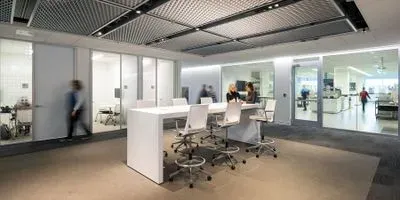
Successful design and delivery of research and development facilities are the result of extensive planning, collaboration, and coordination between the design team and all affected stakeholders. These facilities often include many specialized environments. Some need to be customized for a specific type of research. Others need to be extremely flexible to accommodate different types of research. And still, others need to be modular and replicable across a broad swath of real estate so activities can be scaled up or down, depending on the research priorities at a given time. Given this complexity and the high cost per square foot for state-of-the-art science and technology spaces, good project execution can significantly influence the return on investment of the proposed space. An organized, collaborative project management and delivery approach gives all stakeholders the confidence that they are getting the best outcome for their efforts and their investment.
Here are five strategies for successful project team communication and collaboration:
1. Get the right people in the room
Before the project gets underway, make sure the right people are in the room to participate and give input into the design. From the R&D institution, representation from scientific program leadership, corporate real estate, research teams, operations, and engineering is critical.
Ideally, participants should include people who:
- Understand the science: This should not necessarily be limited to leaders of the research programs. Users who can paint a clear picture and provide vivid details about their day-to-day work should also be included.
- Are committed to the future of the company or institution: Design charrettes and meetings can easily dissolve into territorial discussions about who gets what space and where. Ideally, all participants should understand, and buy into, the long-term goals and objectives of the R&D institution and how the project fits with those goals.
- Have the authority to make decisions: If decision makers are actively engaged in the process, they will make more informed decisions, because they have a solid understanding of the data, input, and information being incorporated into proposed design decisions and solutions.
2. Actively listen, observe, and participate
All team members—whether from the R&D institution or the design team—should come prepared to fully engage in the design process and contribute to the dialogue. Lab design projects are often on tight timelines that require efficient decision making to keep moving forward. This may limit stakeholders’ opportunities to give input on a topic. To use time wisely, all project team members should consider the following:
- Provide and read pre-meeting material
- Always include a meeting agenda, and distribute and review it ahead of time
- Ignore other devices: One hour of your focused time will prevent multiple hours of redo
- Ask questions: While an answer might not be available immediately, it should be eventually.
See the sidebar below for some tips on how to actively engage in virtual project meetings, which are increasingly the norm.
All project team members—especially project leaders and managers—should make a conscious decision to be impartial and to actively listen to what all project team members are saying. This is especially important during initial project meetings, as it is often in the early stages of a design project that priorities become apparent.
Information is discerned from listening to a person’s tone of voice, observing group dynamics, and evaluating stakeholder body language. For example, from stakeholder comments on a recent joint venture research lab project, it became clear very early in the design process that the academic client was not as accustomed to the federal agency’s more hierarchical and less consensus-focused decision-making process. Recognizing this, the project manager reconfigured the programming sessions to allow more discussion and interaction before final sign-off was required. In this way, listening, observing, and adjusting accordingly helped facilitate decision making.
3. Use visioning sessions to articulate the future
Designing a state-of-the-art research facility can be daunting, as it requires consideration of not only current needs but future research requirements. Establishing a project vision is one of the most important steps in any project. The visioning process engages stakeholders and leadership by identifying project priorities that will serve as a consistent thread throughout the design process. A strong, shared vision should be both realistic and aspirational as well as measurable, actionable, and clear.
The most successful visioning sessions engage a broad spectrum of constituents. This allows participants who may not frequently interact with one another to better understand the challenges and issues their colleagues face. A variety of visioning exercises, including photo montages, word clouds, and empathy mapping for different user personas, helps groups reach a shared project vision. These exercises enable participants who often represent diverse backgrounds—from scientists and administrators to architects and engineers—to find a common language. The resulting vision statement should be specific enough to help the team make decisions along the way when options must be selected. Placing the vision statement in a prominent location can help ensure it stays front of mind for project team members for the duration of the project.
Lab Quality Management Certificate
The Lab Quality Management certificate is more than training—it’s a professional advantage.
Gain critical skills and IACET-approved CEUs that make a measurable difference.
The visioning statement also helps inform guiding principles for planning and design, including items such as targets for efficiency, adaptability, and flexibility of space, user experience, incorporations of technology, etc. The guiding principles should be referenced when making decisions to ensure that all decisions align with the project’s goals and objectives.
4. Build trust between the R&D institution and the design team
Based on client surveys conducted by HDR, stakeholders begin to fully trust the design team approximately 35 to 40 percent through the project. The design team can jump-start the trust-building process by being transparent and communicative. The more design team members demonstrate there are no hidden agendas, the more comfortable the entire project team will feel trusting each other. R&D institutions should expect that issues inherently arise during any design process; however, they should also expect their architecture, engineering, and construction team to take a proactive, comprehensive approach to help come up with a resolution.
The design team’s project manager should acknowledge when there is a problem and be prepared to come to the table with potential solutions. On a recent project, the lead structural designer identified an issue that had a significant impact on lab module size well into design development. The project manager convened a multidisciplinary team meeting and developed three solutions to solve the issue and presented each to the client, clearly identifying the cost and schedule implications for each.
A responsibility matrix articulates who is responsible for each decision and can be a useful tool for building trust. When established at the beginning of the project, the team understands decision responsibility, and trust is not eroded at a later date when solutions can lead to differing opinions that are not easily resolved otherwise.
Another good strategy for building trust is to incorporate sufficient time for reflection during the design process, especially for stakeholders who come from a scientific background. Researchers are accustomed to scientific problems that they investigate in a highly structured, rigorous manner and where decisions are considered thoughtfully in a timely and prioritized way that minimizes surprises. Building design takes on a similar process. A strong project manager understands how to translate the scientific approach to the design approach—where stakeholders can consider multiple options and have time to reflect on which one they think is best—so that it benefits the whole team.
5. Break down silos
A silo mentality can be a serious threat to an R&D facility project’s success because it prevents groups from coming together around a project vision. Focusing on open communication and emphasizing collaboration can prevent problems associated with a silo mentality. Part of this process is being aware of how people share and consume information. For example, millennials are often more willing to share information than older employees who are more familiar and comfortable with a more formal decision-making process. Additionally, some people are visual learners who prefer to read information rather than listen to it.
The project team should be willing to use different methodologies to help users understand the programmatic or design issues being discussed. That may mean bringing in dynamic, technology-driven tools that can be manipulated in real time to visualize hard data and associated ramifications behind different design decisions. For other project team members, it will be more helpful to conduct a hands-on activity, such as cutting out representative shapes for different pieces of equipment and laying them out on an exploded floor plan in different configurations. And for others still, a full-scale mock-up will be the most helpful.
Visioning goes virtual
The COVID-19 pandemic has changed the design process and the way project teams meet throughout the process. In most cases, project teams are meeting virtually, and project managers and leaders have to figure out how to evolve a process that is reliant on in-person engagement into a new format.
Here are a few best practices that each project team member should follow to do their part:
1. Engage: Ask questions, have opinions, and use the chat box to let the design team know if they are on target or need to rethink the solution.
2. Turn your camera on: Expressions are one of the fastest ways for the design team to know if they are heading in the right direction or are off base.
3. Be courteous: Not all virtual meetings can happen in short periods and you may need to step out for a bit. Letting the rest of the team know when you do helps them be aware that they might need to wait on a significant decision or catch you up later. The chat box is a great tool for this.
Framing a project issue that requires stakeholders and design team members to collaborate to develop a solution can also help break down silos. On a recent interior renovation at a pharmaceutical research facility, existing conditions limited the floor-to-floor height, resulting in an extremely tight above-ceiling restriction to distribute engineering services. The project manager scheduled an “all-hands-on-deck” charette with members of the client’s facilities group, the construction manager, and the design team, who were able to collaborate to devise an innovative solution. A detailed layered approach to distribution was used to stay within the existing condition. With the construction manager as part of the discussion, the design team was able to address constructability proactively during design rather than reactively during construction.
Foundation for success
Successful laboratory research facility projects are inherently complex and take a long time from concept to completion. The strategies outlined above will help project teams problem-solve throughout the process, create a shared understanding of the project, and inform design solutions that have buy-in from all stakeholders. These strategies, combined with traditional project tools like comprehensive minutes, critical path schedules, and stringent cost and quality control programs, will help ensure a successful research laboratory facility project.












